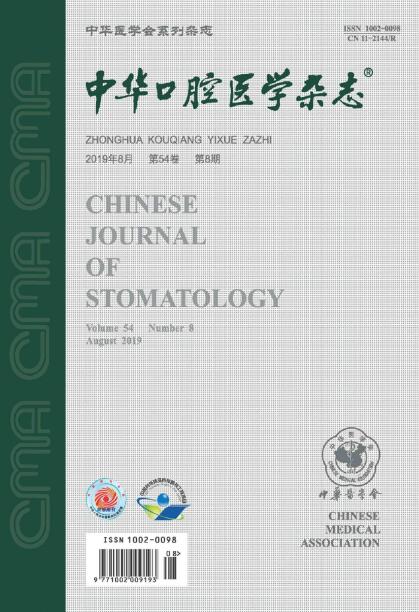Hall技术修复乳牙大面积龋的预后及咬合评价的临床研究
摘要
目的:评价霍尔技术与传统金属冠前修复技术的预后,并随访霍尔技术治疗前后牙合变化,为霍尔技术的推广提供参考。方法:对2021年5月至2022年12月在四川大学华西口腔医院儿科牙科就诊的儿童按照纳入和排除标准进行筛查。分别于术后1、2、3个月三个时间点对两组患者的治疗效果进行随访。观察结果分为成功(牙冠就位,无牙髓炎或根尖周炎症状,咬合无明显异常,无需进一步治疗)、部分失败(牙冠脱落或折断,牙缺损可修复,可逆性牙髓炎)和完全失败(不可逆性牙髓炎或根尖周炎,牙冠脱落,牙缺损不可修复)三种结局,并进行统计分析。同时,Hall技术组分别于术前、术后即刻、术后2周、术后4周、术后8周5个时间点进行随访,通过Dental PrescaleⅡ系统对牙合情况进行分析。记录并比较牙合垂直尺寸(VDO)、上牙合覆盖、犬科关系。采用三维有限元法对传统金属冠前处理与Hall方案处理后的牙体应力进行建模分析,并比较两者的差异。结果:最终纳入Hall技术治疗组21例,其中男孩12例,女孩9例,年龄(5.0±1.4)岁。传统金属预冠组22例,男15例,女7例,年龄(5.1±1.3)岁。Hall方案组完全失败0例,部分失败0例,传统冠前组完全失败0例,部分失败0例。Hall方案组完全失败0例,部分失败1例,传统冠前组完全失败0例,部分失败0例。Hall方案组术后3个月完全失败1例,部分失败1例,传统冠前组术后3个月完全失败0例,部分失败0例。Hall方案组与传统冠前组的主要指标/完全失效和次要指标/部分失效发生率比较,差异均无统计学意义(P < 0.05)。Hall方案患儿术后即刻咬合面积和咬合力较术前下降,术后2、4周逐渐恢复至术前水平,其中即刻咬合面积由术前(14.79±3.55)mm2显著下降至术后(10.15±3.17)mm2 (P=0.001),术后8周恢复至(15.58±3.39)mm2。咬合力由术前(436.94±109.59)N显著下降至术后即刻(292.70±96.05)N (P=0.001),术后8周恢复至(441.86±104.31)N (P=0.999)。复咬合由术前(2.54±1.05)mm降至术后即刻(1.80±0.94)mm (P=0.044),再恢复至术前(2.35±1.02)mm (P=0.962)。覆盖面积由术前(2.41±0.66)mm增加到术后即刻(2.27±0.61)mm (P=0.987),再恢复到术前(2.48±0.62)mm (P=0.998)。术前犬型关系为(3.12±0.54)mm,术后即刻下降(2.17±0.89)mm (P=0.001), 8周后恢复为(3.05±0.61)mm (P=0.993)。在三维有限元分析中,Hall方案处理后患牙各部位最大应力立即升高,但随着咬合调整,患牙各部位最大应力下降,与传统金属预冠组相似,预冠的垂直载荷和斜向载荷从180.11和496.16 N下降到108.05和297.69 N;分别。牙釉质的垂直和斜向载荷分别从94.83和255.94 N降低到57.21和156.44 N。牙本质竖向载荷和斜向载荷分别从55.19和124.77 N降低到33.19和74.59 N。结论:在实验观察期内,Hall方案与传统金属冠前治疗技术在治疗后咬合及临床预后方面无明显差异,支持临床应用。Objective: To evaluate the prognosis of Hall technique and traditional metal pre-crown restoration technique, and to follow up the occlusal changes before and after treatment with Hall technique, so as to provide reference for the promotion of Hall technique. Methods: Children who visited the Department of Pediatric Dentistry, West China Hospital of Stomatology, of Sichuan University from May 2021 to December 2022 were screened according to the inclusion and exclusion criteria. The therapeutic effects of the two groups were followed up at three time points: 1, 2 and 3 months after operation. The observation results were divided into three outcomes: success (crown in place, no symptoms of pulpitis or periapical periodontitis, no obvious abnormality in occlusion, no need for further treatment), partial failure (crown falling off or crown broken, tooth defect can be repaired, reversible pulpitis) and complete failure (irreversible pulpitis or periapical periodontitis, crown falling off and tooth defect irreparable), and statistical analysis was made. At the same time, the Hall technique group was followed up at five time points before operation, immediately after operation, 2 weeks after operation, 4 weeks after operation and 8 weeks after operation respectively, and the occlusion was analyzed by Dental Prescale Ⅱ system. The vertical dimension of occlusion (VDO), overbite coverage and canine relationship were recorded and compared. Three-dimensional finite element method was used to model and analyze the stress of the teeth treated with traditional metal pre-crown treatment and Hall scheme, and the differences between them were compared. Results: Finally, 21 children were included in the Hall technique treatment group, including 12 boys and 9 girls, with age of (5.0±1.4) years. There were 22 children in the traditional metal pre-crown group, including 15 boys and 7 girls, with age of (5.1±1.3) years. There were 0 cases of complete failure and 0 cases of partial failure in the Hall scheme group, 0 cases of complete failure and 0 cases of partial failure in the traditional pre-crown group. There were 0 cases of complete failure and 1 case of partial failure in the Hall scheme group, 0 cases of complete failure and 0 cases of partial failure in the traditional pre-crown group. Hall scheme group failed completely in 1 case and partially in 1 case 3 months after operation, while the traditional pre-crown group failed completely in 0 cases and partially in 0 cases 3 months after operation. There was no significant difference in the incidence of primary index/complete failure and secondary index/partial failure between Hall scheme group and traditional pre-crown group (all P>0.05). The occlusal area and occlusal force of children treated with Hall scheme decreased immediately after operation compared with that before operation, but gradually recovered to the preoperative level at 2 and 4 weeks after operation, in which the occlusal area decreased significantly from (14.79±3.55) mm2 before operation to (10.15±3.17) mm2 immediately after operation (P=0.001), and recovered to (15.58±3.39) mm2 at 8 weeks after operation. The bite force decreased significantly from (436.94±109.59) N before operation to (292.70±96.05) N immediately after operation (P=0.001), and recovered to (441.86±104.31) N at 8 weeks after operation (P=0.999 compared with before operation). Overbite decreased significantly from (2.54±1.05) mm before operation to (1.80±0.94) mm immediately after operation (P=0.044) and then recovered to (2.35±1.02) mm (P=0.962 compared with before operation). The coverage changed from (2.41±0.66) mm before operation to (2.27±0.61) mm immediately after operation (P=0.987) and then recovered to (2.48±0.62) mm (P=0.998 compared with before operation). The canine relationship was (3.12±0.54) mm before operation, and decreased significantly immediately after operation (2.17±0.89) mm (P=0.001), and recovered to (3.05±0.61) mm after 8 weeks (P=0.993 compared with before operation). In the three-dimensional finite element analysis, the maximum stress of all parts of the affected tooth increased immediately after Hall scheme treatment, but with occlusal adjustment, the maximum stress of all parts of the affected tooth decreased, which was similar to that of the traditional metal pre-crown group, and the vertical load and oblique load of pre-crown decreased from 180.11 and 496.16 N to 108.05 and 297.69 N; respectively. The vertical load and oblique load of enamel decreased from 94.83 and 255.94 N to 57.21 and 156.44 N, respectively. The vertical load and oblique load of dentin decreased from 55.19 and 124.77 N to 33.19 and 74.59 N respectively. Conclusions: During the experimental observation period, there is no obvious difference between Hall scheme and traditional metal pre-crown treatment technology in terms of post-treatment occlusion and clinical prognosis, which supports clinical application.

 求助内容:
求助内容: 应助结果提醒方式:
应助结果提醒方式:


